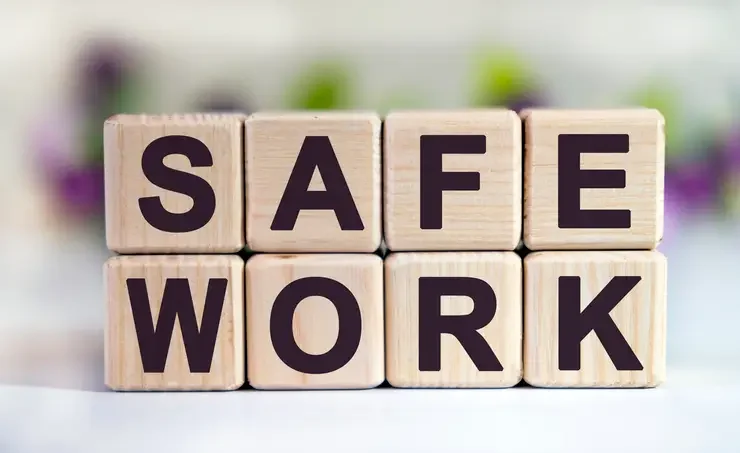These Were The Top 10 OSHA Violations In 2023
At the heart of OSHA’s mission is ensuring safe and healthful working conditions for employees through setting and enforcing standards and by providing training, outreach, education, and assistance. The annual reports developed by OSHA on the top 10 most frequently cited standards bring attention to common safety hazards and also areas that have been flagged for concern.
These reports guide the employers on the priority of safety measures, but they also reveal the consequences in case of non-compliance: from serious injuries and diseases to fatal outcomes. Compliance with such standards is hence underlined as a vital factor for the maintenance of health among workers and the proper execution of operations.
Top 10 Violations

1. Fall Protection (1926.501):
Fall protection violations usually occur where the fall protection systems required by the standard are lacking: e.g., guardrail systems, safety net systems, or personal fall arrest systems in areas where employees are exposed to fall hazards: for example, rooftops or above open pits.
Topping the list with 7271 violations against 5980 in 2022, fall protection continues to throw up key issues in preventing falls, more so in construction safety. It is the most frequently cited violation. This persistent high number suggests an increasing focus on safety equipment usage and training.
2. Hazard Communication (1910.1200):
The common violations are under hazard communication when an employer does not properly label hazardous chemicals, maintain safety data sheets readily accessible to all employees, or provide proper training of workers on the dangers of the chemicals that could be faced while on duty.
The numbers show a slight decrease from last year’s number of 3,213 cases but are still very high. This standard demonstrates the need for proper labeling and training regarding hazardous chemicals, thus showing that work is still required in that area.
3. Ladders (1926.1053):
Common violations in this category include the use of ladders not suitable for the task (e.g., too short, damaged), improper setting up (e.g., on surfaces that are not even), and exceeding the maximum load capacity.
This standard recorded 2,978 violations compared to 2,143 in the year 2022, thus a rise in the issues to deal with improper ladder use. This simply speaks of more necessity for adherence to safety protocols for the use and maintenance of ladders.
4. Scaffolding (1926.451):
General scaffold violation occurs when the scaffold is not erected according to the manufacturer’s guidelines or safety standards and is, therefore, exposed to such hazards as falling over or collapsing. Most of the time, there is an absence, especially of planks, insufficient guardrails, or overloading.
The reported violations increase to 2,859 in the year 2023 from 2,796 in 2022, pointing towards an downward trend in safety in regards to scaffolding. The increasing continued high number in scaffolding safety shows that it is a very important area for enforcement.
5. Powered Industrial Trucks (1910.178):
Powered industrial trucks which were cited for violation usually occurs when forklifts and other industrial trucks are in use by insufficiently trained operators and are poorly maintained (e.g., faulty brakes and steering), or when they are in operation and poorly used (e.g., driving at high speeds, improper loading).
The number of issued violations was 2,561 in 2022 only a slight decrease from 2,625. The amount of violations, although slightly reduced, is still relatively high, which demonstrates a sustained risk relating to the industrial trucking operation.
6. Lockout/Tagout (1910.147):
Lockout covers violations by proper lockout/tagout procedures—procedures that could strictly be followed during the servicing and maintenance of equipment, hence leading to an unexpected energization or start-up that may cause injuries.
It recorded slight increases in the number of violations, from 2,534 last year to 2,554, still suggesting persistent challenges in proper management of dangerous energy for maintenance of equipment.
7. Respiratory Protection (1910.134):
Respiratory protection which was cited for violation may take the form of an employer’s failure to furnish his employees with proper respiratory protection or a comprehensive respiratory protection program or failure on his part to see that fit-testing of equipment is properly conducted.
Of the violations of this standard, there were 2,481, slightly fewer than 2,527 in 2022, thereby slightly improving compliance but still bearing many of the issues in respirational safety importance in air quality concerns in workplaces.
8. Fall Protection (1926.503):
Violation of fall protection is done when the employer has not conducted adequate training for his employees on recognizing the hazards of falling and the functionality of the fall protection system.
In 2023 almost 2,112 violations were reported which were less than last year’s 2,204. A note of improvement in training workers on fall protection, while still underscoring the need for more emphasis on the education of workers in this critical area.
9. Eye and Face Protection (1926.102):
Normally, these are breaches that occur when the employer does not ensure that the workers are availed with the right protective equipment, including safety glasses or face shields, if there are flying particles, molten metal, liquid chemicals, or injurious light radiation.
It is a frequently cited standard reported 2,074 times in 2023, down slightly from 2,153 in 2022 reflecting a small improvement but remaining a big area of concern in protecting workers from eye and face injuries.
10. Machine Guarding (1910.212):
Violation of this standard takes place when the machinery is running without guards, and an employee is exposed to moving parts that are supposed to result in amputations, crushing injuries, or fatal accidents. This standard remains critical, with a decrease in violations from 1,670 in 2022 to 1,644, suggesting some slight progress in safeguarding machinery to protect workers against potential hazards.
These comparisons indicate the improvements and constant challenges for workplace safety. They highlight one of the critical benchmarks for the sector to increase its focus on increasing the efforts towards compliance and training that make for fewer violations and more safety for workers.
Tips for Reducing These Violations
To help you continue to provide a safe working environment and reduce the risk of OSHA violations, we’ve included some general tips and an increased focus on safety resources within your safety training regimen:
- Training at regular intervals: Give training on safety from time to time. Use the Outreach Training Program from OSHA with its 10-hour and 30-hour courses for both the construction industry and general industry for an update to the workers.
- Regular Safety Audits: Carry out safety audits following a schedule to find out possibilities. Use its findings to further train operational procedures.
- Communication: Clear use of communication in every safety procedure. Use of visual aids or any means of communication. All signage should also be current with the OSHA standards.
- Provide the right equipment: Equip workers with the necessary personal protective equipment (PPE) and train them on how to properly wear it.
- fety Culture Enforcement: Promote the culture of the organization where safety gets implemented. Make the environment such that workers can report hazards without any fear of the consequences.
These practices, along with educational courses of OSHA, could enable employers to provide a workforce with a safer environment for work while performing above all the requirements of compliance at the same time supporting a culture of safety and welfare of all employees.
Conclusion
Strict adherence to safety resources, regulations and ongoing training via OSHA-approved courses greatly improve worker safety and compliance. It also helps reduce these most frequently cited violations. These could be through clear communication, regular safety audits, or proactive establishments of safety cultures in organizations. From an OSHA perspective, this indeed ensures that employers and employees are better armed with the right sets of tools to maintain safety standards and thus a safer place of work.





